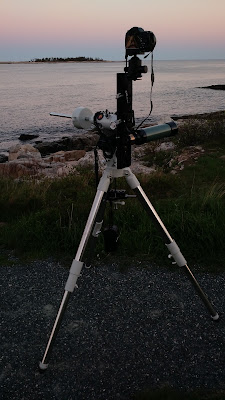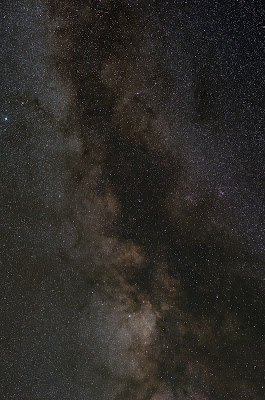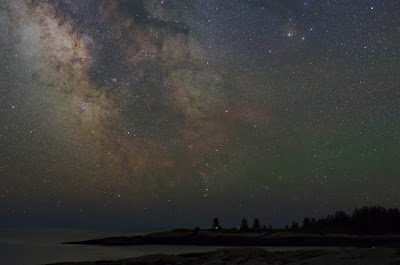This past winter, with much idle time, my mind wandered and dreamt of summer observing. Fast Forward to earlier this month. The moment arrives and the weather forecast looks promising. The equipment is all set and it is going to be a great night!
Because the view east at my home is obstructed with trees and the opening to my south is limited, I chose to go to Schoodic Point. The skies are a bit darker and the horizon is ideal. I was particularly interested in points south of Messier 8 down to about -40 degrees declination, maybe a bit further if atmospheric extinction was tolerable.
I arrived at a small parking area on the east side of the Schoodic Peninsula around sunset. Schoodic is part of Acadia National Park east of Mount Desert Island. I had documented the dark skies here in 2008, as part of a cooperative agreement between the National Park Service and the Island Astronomy Institute. The resulting Nightscape Survey revealed pristine skies overhead and in the areas facing away from population centers, primarily south. The survey showed Schoodic to be a dark sky haven, quite possibly the best east of the Mississippi. Typical Sky Quality Meter (SQM) readings average 21.75-21.85 mags/sq-arc-sec with no Milky Way overhead.
 |
| Looking southeast after sunset, the Belt of Venus appears over the Atlantic |
I'm a frequent flyer at Schoodic. I've been photographing from this beautiful location for about a decade. It is special to say the least and more and more people are discovering it. May is the perfect time for me to arrive here for this special night. The tourists have yet to arrive and visitors tend to be local. May is also a great time to get a jump on the wonders of the summer sky, you just need to stay up well past midnight to see them.
 |
| The Equatorial Mount and DSLR |
It only takes about 30 minutes to set up the equipment and once Polaris is visible a few minutes to polar align the mount. The window for dark skies, the time from astronomical twilight ending and beginning would be from 10:10 PM to 2:46 AM EDT. Moonrise would coincide with the onset of astronomical twilight at 2:45 AM. Roughly a 4-1/2 hour window of darkness.
 |
| Checking focus on the Vixen 16x80 binoculars |
As much as I had planned on doing astrophotography from this site, I was anxious to get a glimpse of the full glory of Sagittarius' Great Star Cloud and point southward. I came equipped with a pair of Vixen 16x80 and SG2.1X42 binoculars. Touring the Milky Way with binoculars is perhaps the easiest way to enjoy the great star masses as well as bright and dark nebulae. Under dark skies, these smaller instruments really are the best way to see them.
The evening began with a panorama of the Milky Way rising in the east. I used four images with a fast wide angle lens. The view includes light domes from Machias which is the largest population center looking north. Fortunately it is in the opposite direction of where I will be looking come early morning.
 |
| The Milky Way rise! |
 |
| The Great Sagittarius Star Cloud rises over Schoodic Island. The glow of the star cloud is reflected in the ocean waters. |
There was a fair amount of natural air glow, both red and green varieties revealed in the photographs. As the Milky Way worked its way towards the meridian things were getting very interesting. In the large binocular the essential bright and dark structures were obvious. The west side of the Great Star Cloud was magnificent! Dark structures superimposed over the great mass of suns were opaque and the whole background glowed! Words fail to describe how wondrous this object is. My instinct upon seeing this is to sell all my photo gear and invest in more visual equipment!
 |
| The full splendor of the Galactic Center |
The image above was the image I was after. The frame sets just above the ocean line and extends beyond -40 degrees declination. The air glow hindered the lowest portion of the image, but I am happy with it.
 |
| Wondrous Night at Schoodic |
I'm taking in the view as the camera and tracking platform do its work. Seeing this deep and this wide is a privilege. Most Americans don't get to see this. The night skies of this particular area of Maine are a treasure. It needs protection. If we ever loose sight of our home galaxy we are doomed in my opinion. Perhaps.
 |
| The Great Rift through Aquila and Scutum |
The clarity of the skies north of Sagittarius stand out. The image of the Great rift above illustrates fine details, much of which can be seen in extensive detail in binoculars.
 |
| Southern delights hang above illuminating Schoodic Point |
Seeing the entire tail of Scorpius above the horizon was a joy to view unaided and with the SG2.1x42 binocular. Descriptions would fail to convey just how awesome (in the true meaning of the word) this is. A visual feast for the avid stargazer. In my almost 40 years of observing the night sky, this was a night to remember.
 |
| Moonrise marks the end of the night and morning light begins |
The darkness is coming to an end and in the northeast Moonrise is occurring. Inspired by the hours of observing I am compelled to read aloud, alone on the peninsula, my favorite poem by none less than Robert Burnham Jr.
Midnight.....
There is no sound in the forest -
only the phantom murmur
of the far wind
and the wind's shadow drifting
as smoke
through ebon branches; there a single star
glistens in the heart of night....
A star!
Look skyward now...
and see above...INFINITY
Vast and dark and deep
and endless....your heritage:
Silent clouds of stars,
Other worlds uncountable and other suns
beyond numbering
and realms of fire-mist and star-cities
as grains of sand....
drifting...
Across the void....
Across the gulf of night....
Across the endless rain of years....
Across the ages.
Listen!
Were you the star-born you should hear
That silent music of which the ancient sages spoke
Though in silent words...
Here then is our quest
and our world
and our Home.
Come with me now, Pilgrim of the stars,
For our time is upon us and our eyes
shall see the far country
and the shining cities of Infinity
which the wise men knew
in ages past, and shall know again
in the ages yet to be.
Look to the east....there shines
the Morning Star...soon shall the sunrise come...
We await the Dawn,
Rise, oh eternal light;
Awaken the World!
With trumpets and cymbals and harp and the sound
of glad song!
And now...
The clouds of night are rolled away;
Sing welcome to the Dawn
Of the bright new day!
From Burnham's Celestial Handbook, by Robert Burnham Jr., 1978.